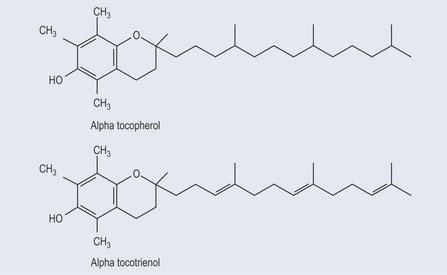Chapter 13 Vitamins and minerals
Reference Values
There is now a move to change all these, amalgamating them into the dietary reference intake (DRI), which takes into account the above values.
People at Risk from Deficiencies
Any condition of the gastrointestinal tract that reduces absorption can put the individual at risk of a vitamin deficiency (see Chapter 15 ‘Methods of administration’, p. 119). Other causes include:
Metals
Two Important Elements
Magnesium
Thus adequate levels of magnesium in the body are important.
• Facts about Magnesium
Calcium
• Interaction of Food Substances with Calcium
Trace Elements
Iron
• When can Iron Deficiency Occur?
For symptoms of iron deficiency anaemia, see Chapter 28 ‘Blood disorders’ (p. 209).
• Sources of Iron
There are, however, ways of increasing non-haem absorption:
Copper
Copper is a cofactor in various metabolic processes:
• Copper Deficiency
Blood disorders (see Chapter 28 ‘Blood disorders’, p. 209 and Chapter 41 ‘Scientific tests’, p. 331):
Zinc
Chromium
Manganese
• Nutrient Interactions
Selenium
Suppression of free radicals: selenium is a cofactor for glutathione peroxidase (see Chapter 7 ‘Free radicals’, p. 47 and Chapter 19 ‘Pharmacodynamics: how drugs elicit a physiological effect’, p. 139).
Molybdenum
A cofactor in various metabolic processors (see Chapter 19 ‘Pharmacodynamics: how drugs elicit a physiological effect’, p. 139):
Iodine
Vital for the normal function of the thyroid gland (see Chapter 37 ‘Metabolic disorders’, p. 288).
Water-Soluble Vitamins
Vitamin C and the B-complex Vitamins
Vitamin C (Ascorbic Acid)
• Absorption of Ascorbic Acid
The absorption of ascorbic acid occurs actively as well as passively (see Chapter 16 ‘How do drugs get into cells?’ p. 123). When the concentrations of ascorbic acid are low, active transport predominates, whereas at high concentration the active transport system becomes saturated leaving only passive diffusion. Therefore, slowing down the rate of stomach emptying (see Chapter 15 ‘Methods of administration’, p. 117) or providing a slow-release form of ascorbic acid should increase its absorption.
• High Doses
B-complex Vitamins
These are divided into those associated with:
• B Vitamins Involved with Energy Production
B1 (Thiamin)
Vitamin B3 (Niacin or Nicotinic Acid)
Forms part of the nicotinamide adenine dinucleotide (NAD) structure (see Figure 12.3, p. 91 and Chapter 19 ‘Pharmacodynamics: how drugs elicit a physiological effect’, p. 139).
Vitamin B5 (Pantothenic Acid)
Involved in synthesis and oxidation of fatty acids and other important energy- producing reactions (see Chapter 19 ‘Pharmacodynamics: how drugs elicit a physiological effect’, p. 139).
Vitamin B6 (Pyridoxine, Pyridoxal and Pyridoxamine)
• Haemopoietic B Vitamins
Vitamin B12
Its structure is similar to that of chlorophyll (see Figure 9.1, p. 64) and the haem structure found in red blood cells, but with cobalt instead of magnesium or iron.
Deficiency
Reasons for Vitamin B12 Deficiency
As vitamin B12 is found only in animal food sources, it might be necessary for vegans to use vitamin B12 supplementation.
Drug Interactions Specific to Vitamin B12
Fat-Soluble Vitamins
Vitamin A
Vitamin D
Vitamin E (Alpha Tocopherol)
Two groups of compounds have vitamin E activity (Figure 13.1):
• Interactions with Anticoagulant Medication
Vitamin K
References
Bibliography
Sanders T, Emery P. Molecular basis of human nutrition. New York: Taylor and Francis;; 2003.
United States Department of Agriculture. National Agricultural library. DRIs for vitamins, electrolytes and water, elements and macronutrients. Online. Available: http://desearch.nal.usda.gov/cgi-bin/dexpldcgi? gry1383539189; 1 [accessed 2 March 2008].








